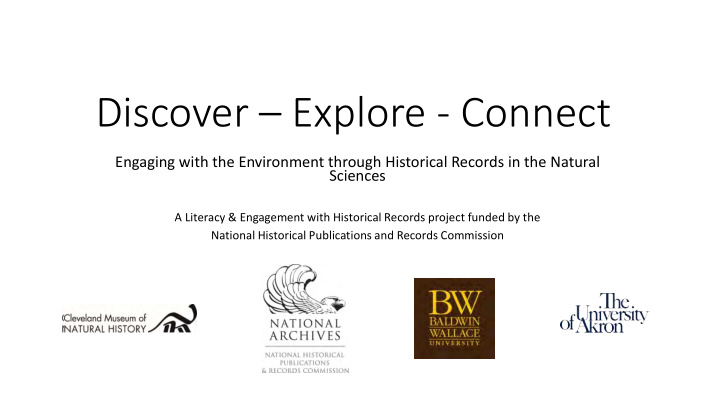



Discover – Explore - Connect Engaging with the Environment through Historical Records in the Natural Sciences A Literacy & Engagement with Historical Records project funded by the National Historical Publications and Records Commission
Goals • Make primary sources in the sciences accessible • Create a model for teaching with primary sources in middle school and high school science classrooms • Improve digital literacy • Get outside!
Roots: Middle School Students Meet the Archives • Introduction to primary sources from the Museum Archives • Hands-on exploration of historical records
Arthur B. Williams, Naturalist, Educator
Following in the footsteps of A.B. Williams
Following in the footsteps of A.B. Williams
Growing the Trees: NHPRC Grant • Funding period: July 2016 – June 2018 • Objectives: • Digitize Arthur B. Williams Collection from Museum Archives and make material freely accessible • Create curriculum • Teach the teachers • Create an advisory panel of archivists and teachers to assist with product development and implementation
Digitization • Collection includes field notes, maps, zoological data, scrapbooks, photos, manuscripts • Baldwin Wallace is the digitization partner for project • Material is scanned at BW • Stored on OCLC CONTENTdm • Public access via LibGuides
Technical Details • Resolution: 600 dpi • 16-bit grayscale • Fragile materials scanned manually; sturdy materials scanned using feeder • Documents saved as multi-page PDFs; stitched together and OCR’d using Adobe Acrobat CC • Uploaded to CONTENTdm • Items tagged using controlled vocabulary from Library of Congress Authorities
Curriculum: Experiential Learning • Hands on experience for BW students • Proper techniques for digitization • Metadata creation • Quality control of curated content • Marketable post-grad skill sets
Curriculum: Teaching with Primary Sources • Teacher Institute to be held December 2, 2017 • What is a primary source? • How to find primary sources in the sciences • Using the Discover – Explore – Connect online repository • Keeping field journals
Curriculum: In the Field • Walking in the footsteps of early naturalists • Orienteering: using maps, compasses, binoculars • Gathering data • Comparing data
Digital Literacy • Collaboration with University of Akron, Dept. of Geosciences • PDF GIS map • Georeference the scanned PDF by aligning it with existing elevation and hydrography data • Once aligned, a copy is created that can be used with other data in GIS • Error is +/- 50 ft
GIS map Point dataset • Create datasets of points to represent observations • Add attributes to those points • Point datasets are useful for cartographic and analytical applications
Sustaining the Forest: Future Collaborative Projects
Collaborative Benefits Expertise Equipment • • Intellectual synergy Software • • Fresh perspectives Additional workforce • • Symbiotic relationship Increased visibility • • Increased likelihood of funding Additional audiences • •
Questions? Wendy Wasman, Librarian & Archivist Cleveland Museum of Natural History wwasman@cmnh.org Kieth A. Peppers, Archivist & Prof of Public History Baldwin Wallace University kpeppers@bw.edu
Recommend
More recommend